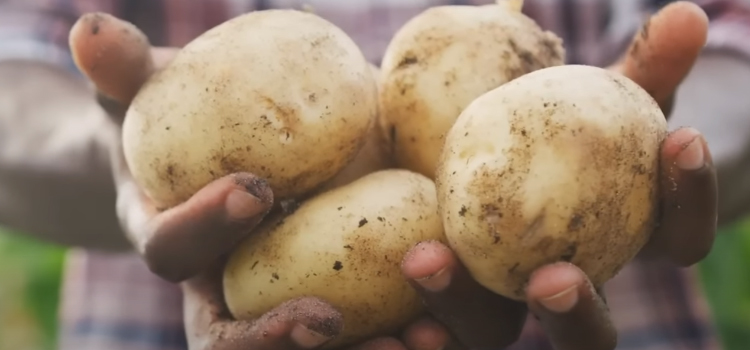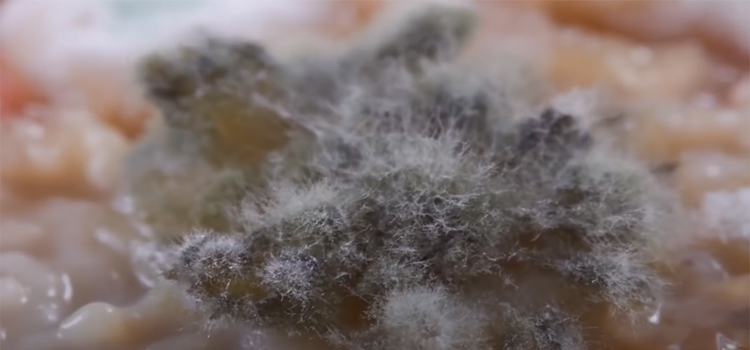Last Updated on September 13, 2024 by Shari Mason
Finding moldy potatoes in your pantry can be quite a shock. They look nasty, and mold on potatoes can easily spread to other foods, potentially causing serious health issues if consumed.
I remember discovering a moldy potato in my pantry and wondering if its companions were compromised, too.
So if one potato has mold, are they all bad? Keep reading to find out.
Are Potatoes All Bad If One Has Mold?


If one potato [1] has mold, it does not necessarily mean that the rest of the potatoes in the bag are bad. The mold on one potato can be isolated to that one potato and may not have spread to the others.
“In the world of spuds, mold can be a stealthy traveler. A single culprit might signal a potential domino effect, urging us to separate the tainted from the untouched to preserve the goodness of our potato collection.”
– Eat Pallet Restaurant & Food Advice
To determine the safety of the rest of the potatoes, you should inspect each one for signs of mold or soft spots. If you find that all potatoes have mold, they should all be discarded.
If some potatoes in the bag appear to be good, then they can still be consumed. However, it is important to cook them properly to ensure they are safe to eat.
Make sure to scrub the potatoes thoroughly before cooking and discard any that have soft spots or are discolored.
Additionally, cook the potatoes until they are well done, and avoid storing any cooked potatoes for more than four days.
Read:
- If One Potato Is Rotten, Are They All Bad?
- How To Tell If Shredded Cheese Is Bad?
- How To Tell If Queso Fresco Is Bad?
What Causes Mold In Potatoes?
Mold in potatoes is caused by a combination of warm temperatures and high humidity, which encourages the growth of spores from fungi.
This can be exacerbated by improper storage of potatoes, such as storing them in a damp area, not allowing them to dry properly after harvesting, or not keeping them cool enough.
These conditions can create a hospitable environment for mold growth on potatoes.
How To Prevent Molds


The best way to prevent molds from growing in potatoes is to store them in a cool, dry place. Potatoes should be stored in a dark, well-ventilated area, as exposure to light can cause them to turn green and develop a bitter taste.
Potatoes should be stored in a container that is not airtight, as this can cause them to become too moist and encourage mold growth.
Additionally, potatoes should be checked regularly for any signs of spoilage, such as discoloration or soft spots, and discarded if they show any signs of mold growth.
“My wife is a terrific Southern cook. My favorite of all the great things she cooks is ‘trash potatoes.’ That’s mashed potatoes with sour cream, bacon, cheddar cheese, and horseradish. It’s a total gut bomb. “
– Mike Vogel, American Actor
It is important to keep potatoes away from other fruits and vegetables, as these can produce ethylene that can cause potatoes to spoil faster.
Potatoes should also be kept away from strong odors, such as onions and garlic, as these can absorb the smell and become unappetizing.
Potatoes should be stored in a single layer and not layered on each other, as this can cause them to become too moist and encourage mold growth [2].
Potatoes should be stored in a cool place, as warm temperatures can cause them to sprout and become unappetizing.
Tips On How To Store Your Potatoes
- Keep potatoes in a cool, dry, dark place with plenty of ventilation.
- Store potatoes in a paper bag or a perforated plastic bag. This will help them breathe and keep them from going bad too quickly.
- Avoid storing potatoes near onions, as they can spoil each other faster.
- Check potatoes periodically for signs of spoilage, such as soft spots, mold, or a strong smell.
- Don’t store potatoes in the refrigerator—the cold temperature will cause them to become sweet and spoil faster.
- Don’t store potatoes in direct sunlight, as this can cause them to turn green and become toxic.
- If you have a lot of potatoes, sort them by size and store the smaller ones first, as they tend to spoil faster.
FAQs
u003cstrongu003eWhat is the white fuzzy mold on potatoes?u003c/strongu003e
The white fuzzy mold on potatoes is a type of fungus called Penicillium. It is usually a harmless mold but can cause spoilage in potatoes if not removed.
u003cstrongu003eWhat does mold on potatoes look like?u003c/strongu003e
Mold on potatoes can vary in color and appearance, but it often appears as white, gray, green, or black spots. u003cbru003eu003cbru003eIt may also appear as a fuzzy growth or a slimy, slippery texture on the surface of the potato.
u003cstrongu003eWhat happens if you eat mold on potatoes?u003c/strongu003e
Eating mold on potatoes can cause health problems such as nausea, vomiting, upset stomach, and diarrhea. It can also cause allergic reactions in some people. u003cbru003eu003cbru003eIn rare cases, it can even cause more serious health problems, such as breathing problems, neurological disorders, and even death. Therefore, it is best to avoid eating moldy potatoes.
Key Takeaways
It is important to inspect all potatoes for mold before consuming them. If one potato has mold, the others may not have been affected, but you should still inspect them.
The potatoes should not be consumed and disposed of if mold is found. Additionally, it is important to ensure that potatoes are stored in a cool, dry place to avoid mold growth.
References:
- https://www.britannica.com/plant/potato
- https://www.cdc.gov/mold/faqs.htm
- Can You Put an AC Unit in the Kitchen? - September 27, 2024
- What Cheese Does Olive Garden Use? Discover Their Signature - September 27, 2024
- How to Cancel a Pizza Hut Order? Quick & Easy Guide - September 24, 2024


